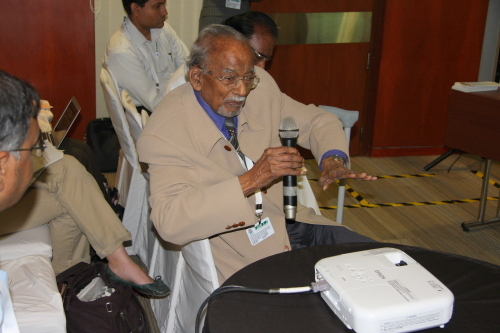Sustainability of wild flora use and livelihoods—framing the global CBD discussion and supporting national implementation
Hyderabad, India, 15th October 2012 - Conservation and sustainable use of wild flora, as well as maintenance of traditional knowledge associated with plants, are critical to meeting the objectives of the Convention on Biological Diversity (CBD). These were discussed during the first week of the 11th meeting of the Conference of the Parties to CBD (CoP11) in Hyderabad. Under agenda item 13.7 on the Global Strategy for Plant Conservation (GSPC) last Thursday, 11 October, Parties discussed the relevant Decision that emerged from the 16th meeting of the CBD’s Subsidiary Body on Scientific, Technical and Technological Advice (SBSTTA 16) earlier this year, and accepted it essentially unchanged. TRAFFIC made a joint intervention with WWF during the session, welcoming the progress in implementing CBD CoP10 Decision (X/17). In particular, the intervention applauded development of the toolkit for implementation of the GSPC, the updating of terms and technical rationales for GSPC targets, and analysis of the applicability of the indicators framework for the Strategic Plan of the GSPC.

“GSPC decisions were endorsed by the CoP and this good framework for delivery now needs to be supported by effective action, including implementation of the GSPC Targets at national level,” said Anastasiya Timoshyna, TRAFFIC’s Medicinal Plants Programme Leader.
Timoshyna also drew attention to the development and use of the FairWild Standard (www.fairwild.org) for socially and environmentally sustainable use of wild plant resources. “The FairWild Standard can be used as a tool to help CBD Parties, other governments and the private sector to implement Targets 11, 12 and 13 of the GSPC”, she said.
The FairWild Standard is included in the new toolkit for implementation of the GSPC (www.plants2020.net) as a means of best practice for delivery of Target 12 and contribution to the delivery of Aichi Target 4. TRAFFIC is also contributing to implementation of the Strategy as a member of the Global Partnership for Plant Conservation (GPPC) (http://www.plants2020.net/gppc/).
Three side-events during the first week of CoP11 focused on a number of implementation challenges for the Strategy:
Wild Flora Online by 2020, a side-event on 11 October, initiated by the GPPC and Missouri Botanical Garden, reported on delivery of Target 1 via “An online flora of all known plants”.
GSPC—Building Capacity to Support National Implementation, a side-event during which Peter Wyse Jackson, Chair of the GPPC and Missouri Botanical Gardens, noted the importance of quality over quantity in capacity-building programmes. Suzanne Sharrock of the Botanical Gardens Conservation International (BGCI) launched the online toolkit developed to support national and regional implementation of the GSPC, now available in all UN languages. Maite Demas of the Natural History Museum of France shared the experiences of the Sud Expert Plantes (SEP) project on capacity-building for plant knowledge, conservation and sustainable use. Cristina Romanelli of the CBD Secretariat drew attention to the initiative of the Secretariat and GPPC to collect information from Partnership members on relevant to GSPC capacity-building activities. The results of this initiative demonstrated that Targets 11, 12 and 13 (all within Objective 3 of the GSPC) are among the least covered by capacity-building activities.
The Sustainable Use objective of the GSPC was a subject of the side-event Towards the Delivery of Aichi Targets 4, 6 and 18 through the Global Strategy for Plant Conservation: Sustainable Use of Wild Plant Resources on Friday, 12 October. This event was co-organized by TRAFFIC with BGCI, the Comisión Nacional para el Conocimiento y Uso de la Biodiversidad (CONABIO), the Foundation for Revitalisation of Local Health Traditions (FRLHT/I-AIM), and the IUCN Medicinal Plant Specialist Group (IUCN-MPSG). It discussed the challenges and opportunities for delivery on the Sustainable Use objective, in particular the halting, jointly with CITES, of international trade that endangers wild flora species, sustainable sourcing (highlighting the FairWild Standard), and maintenance of traditional knowledge related to wild plant use. Hesiquio Benitez Diaz from CONABIO presented on the experiences of the Mexican Government. He explained links between the GSPC’s Target 11 and CITES Plants Committee work in the context of the Mexican strategy for implementing the Target. Anastasiya Timoshyna of TRAFFIC presented on current sustainable use of plant resources, and challenges related to delivery of the GSPC’s Target 12. The FairWild Standard, a set of principles for ecologically, economically and socially fair use in wild plants, which also provides a certification system, was explained as a useful tool to deliver to this Target. Kahoru Kanari presented on TRAFFIC’s efforts to support effective implementation of CITES, directly connected to delivery of Target 11: recent work on capacity-building for national stakeholders, promotion of FairWild, and assisting national Non-detriment Findings (NDF) studies were highlighted. Susanne Sharrock of BGCI talked about a recent study of cases of sustainable use from Brazil, China, India and Mexico, emphasizing the diversity of wild flora used. Jagannatha Rao from FRLHT/I-AIM gave examples contributing to delivery of Target 13 of the GSPC and Aichi Target 18. He emphasized that traditional knowledge associated with use of medicinal plants in India was very extensive, and shared experiences of Indian plant harvesting, and of the latest efforts for documenting knowledge, and sustaining knowledge. Attended by around 40 participants, the event ended with animated discussion of the presentations made.



